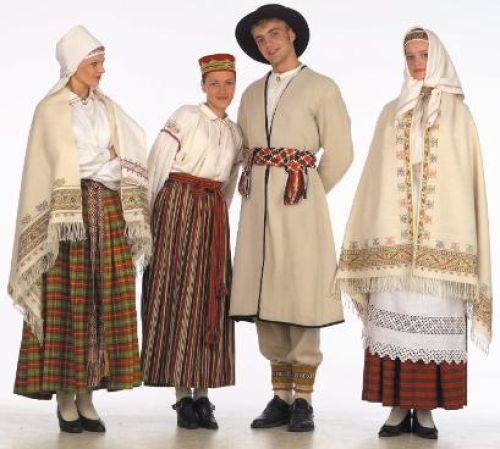This foldout features illustrations of a full women's folk costume and various details:
- sagša (cape/shawl),
- sakta (brooch),
- krekla shema (blouse schematic),
- piedurkņu un apkakles raksts (cuff and collar embroidery),
- vainags (crown/headdress), and
- brunču raksts (skirt weave/pattern),
and descriptive overviews in French, English, Russian, and Latvian.
Latgale
The lands of the Latgalians covered modern Latgale as well as further north into today's Vidzeme. To their north were the Livs, beyond them, the Estonian tribes. To the south were the Selonians (see also the Augšzeme folk costume) and Lithuanian tribes; to the east were the Krivichs. In 1561 Latgale was incorporated into the Polish-Lithuanian Commonwealth at the Treaty of Vilnius. In 1772 it was incorporated into the Russian empire in the first partition of Poland. With the declaration of Latvian independence in 1918, Latgale was declared as incorporated in the new Latvian state.
The archetypal and stylistically cohesive Latgale folk costume is, in fact, the Abrene white folk costume. Over time, the Latgale folk costume absorbed influences from the active trade along the Daugava River (Western Dvina, a trade route back into antiquity), later, the influences of Catholicism under the Polish-Lithuanian Commonwealth and subsequently those under the Russian Empire. Some of the strongest influences in the women's costume as it is seen today date to the 19th century—early in the century for the embroidery found on shawls, the latter half of the century for the plaid and striped weaves of skirts.
The Latgalian Latvian dialect and culture is an ancient one still alive today—and particularly vibrant in music and literature. We recommend the sources below to learn more about this unique slice of Latvia.
Read more
- Latgale Culture and History Museum in Rēzekne
- Regional Portal of Latgale
- ORIGINS OF REGIONAL IDENTITY OF EASTERN LATVIA, (LATGALE) AND APPROACHES TO ITS INVESTIGATION, Aleksandrs Ivanovs, Henrihs Soms
- Latgale Research Institute (Latgales Pētniecības institūts), part of Daugavpils University, in Latvian
 Gallery
Gallery



